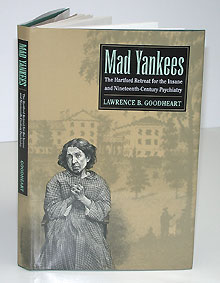|
This is an archived article.
For the latest news, go to the
Advance Homepage
For more archives, go to the Advance Archive/Search Page. | |
|
Historian: First Mental Asylum He had just come from a book signing at the UConn Co-op, carrying a poster-sized enlargement of his latest work, with the title "Mad Yankees" most prominent.
A casual observer might have thought Lawrence B. Goodheart was weighing in on the baseball rivalry between the teams from New York and Boston. But the forlorn-looking woman on the cover is not a long-suffering Red Sox fan; instead, she represents the true focus of his book, as explained in its subtitle, a revealing look at the Hartford Retreat for the Insane and Nineteenth-Century Psychiatry. Goodheart is a professor of history at the University's Hartford campus, specializing in 19th-century American history, slavery, and the Civil War. Mad Yankees (University of Massachusetts Press, 2003) is the sixth book he has written or co-edited, and at first glance it may seem a change of pace from his previous works on abolitionism and African-American issues. But he says working to end slavery and helping the plight of the insane arose from the same reform movement of the early 1800s. "The birth of the mental asylum is part of the utopian thinking to create a better world, that change is both possible and imperative," Goodheart says. This zeal was especially strong in New England, and the Hartford Retreat, opened in 1824, was at the forefront. Its first superintendent, Dr. Eli Todd, promoted the revolutionary notion that mental illness was a disease, not a moral failing. "Todd held that insanity is no different than a fracture of a bone," Goodheart says. "It had organic causes, and could be cured." The mission of the retreat, Connecticut's first hospital of any kind, was to get people out of their homes and the environment that was causing their illness, and bring them into an asylum where they could be treated respectfully, with beneficial medicine and a good diet. Goodheart says the treatment de-emphasized restraints and seclusion, and shackling was used only as a last resort. The retreat changed its name to the Institute of Living in 1943, and in 1994 became affiliated with Hartford Hospital. It has remained at the same location on Washington Street, and some of the original buildings are still intact. The book is footnoted and includes tables and statistics, but is not written as an academic text. In fact, Goodheart offers a very personal look at Todd based on the doctor's notes and the observations of his colleagues. Todd battled prejudice and conventional wisdom in his approaches to treatment, as well as his own personal demons and the status of his mental health. His father died insane, and Todd treated his sister's chronic depression for 40 years before she committed suicide. Goodheart started working on "Mad Yankees' in 1990. He was at the State Library in Hartford, doing research on another topic, when he came across a number of documents on the retreat and Todd. As is often the case, he kept putting the book on hold as other projects and opportunities came along, including a stint of teaching at Bilkent University in Ankara, Turkey, in 1994-95. Goodheart's next project is a book on prisons and punishment during the period 1750 to 1870. He is also finishing a six-year term on the board of education in Hampton, where he lives. |

